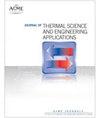横流水冷塔的数值研究
IF 1.4
4区 工程技术
Q3 ENGINEERING, MECHANICAL
引用次数: 0
摘要
本文采用ANSYS CFX软件对强制跨流式水冷塔的性能进行了研究。研究中冷却塔的几何尺寸和边界条件值与实际值较为接近。考察了2m宽、2m长、3m高的冷却塔出水温度对风速、水滴直径和进水温度的影响。对于冷却塔,选择适合设计的数据值。采用2 m/s、4 m/s、6 m/s和8 m/s风速,水滴直径分别为0.01、0.008、0.005和0.001 m,进水温度分别为306.15、309.15、311.15和313.15 K,考察了不同工艺水质量流量值的冷却范围与风速的关系。研究结果表明,随着风速的增大,工艺出水温度降低,但冷却范围增大。随着水滴直径的减小,也观察到类似的情况。然而,观察到,当进口水温升高时,出口工艺水温和冷却间隔也会增加。本文章由计算机程序翻译,如有差异,请以英文原文为准。
Numerical Investigation of Cross-Flow Water Cooling Towers
In this study, the performance of the forced cross-flow water cooling tower was investigated with the ANSYS CFX program. The geometric dimensions and boundary condition values of the cooling towers in the study were taken to be close to the real values. The effect of air velocity, water droplet diameter and inlet water temperature change according to the temperature of the water coming out of the 2m wide, 2m long and 3m high cooling tower was investigated. For the cooling tower, data values suitable for design are selected. The study used air velocities of 2 m/s, 4 m/s, 6 m/s, and 8 m/s, water droplet diameters of 0.01, 0.008, 0.005, and 0.001 m, and inlet water temperatures of 306.15, 309.15, 311.15, and 313.15 K). In addition, the relationship between cooling range and air velocity for mass flow values of different process waters was also investigated. As a result of the study, it was observed that the process leaving water temperatures decreased with the increase of air velocities, but the cooling range increased. A similar situation was observed with the reduction of water droplet diameters. However, it has been observed that when the inlet water temperatures are increased, the outlet process water temperatures and the cooling interval also increase.
求助全文
通过发布文献求助,成功后即可免费获取论文全文。
去求助
来源期刊

Journal of Thermal Science and Engineering Applications
THERMODYNAMICSENGINEERING, MECHANICAL -ENGINEERING, MECHANICAL
CiteScore
3.60
自引率
9.50%
发文量
120
期刊介绍:
Applications in: Aerospace systems; Gas turbines; Biotechnology; Defense systems; Electronic and photonic equipment; Energy systems; Manufacturing; Refrigeration and air conditioning; Homeland security systems; Micro- and nanoscale devices; Petrochemical processing; Medical systems; Energy efficiency; Sustainability; Solar systems; Combustion systems
 求助内容:
求助内容: 应助结果提醒方式:
应助结果提醒方式:


